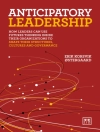‘A good balance between theory and practice . . . it definitely fills a void in the [lack of] texts in the area and the change literature in general . . . a good fit for my graduate class on ′Managing Organizational Change.′’
—Anthony F. Buono, Mc Callum Graduate School of Business, Bentley College
‘Like Gareth Morgan′s Images of Organization , this book is a superb blend of theory and practicality. It demystifies chaos and paradox, and it encourages the understanding of organizational dynamics from multiple perspectives. It is refreshing to read a book that presents diverse theories and interventions so even-handedly.’
—Andrea Markowitz, Ph.D., President, OB&D, Inc.
Learning to Change: A Guide for Organizational Change Agents provides a comprehensive overview of organizational change theories and practices developed by both U.S. and European change theorists. The authors compare and contrast five fundamentally different ways of thinking about change: yellow print thinking, blue print thinking, red print thinking, green print thinking and white print thinking. They also discuss in detail the steps change agents take, such as diagnosis, change strategy, the intervention plan, and interventions. In addition, they explore the attributes of a successful change agent and provide advice for career and professional development. The book includes case studies that describe multiple approaches to organizational change issues.
This book will appeal to both the practitioner and academic audiences. It can be used as a text in graduate courses in change management and will also be a useful reference for consultants and managers.
Features:
- Discusses the abilities, attitudes, and styles of successful change agents
- Describes five fundamentally different ways of thinking about change
- Presents a state-of-the-art overview of change management insights, methods, and instruments
- Summarizes an extensive amount of organizational change literature
- Supplies readers with useful insights and courses of action that will allow them to design and implement change professionally
Learning to Change became a bestseller upon its initial publication in the Netherlands. The color-model on change is very popular among thousands of managers and change consultants and presents a new approach to change processes and a new language for change.
Зміст
Preface
Introduction
Why Change is so Complicated
On Loosely Coupled Systems
On Managing and Being Managed
On Chaos Thinking
Sociopolitical Mechanisms
Four Irrational Families of Theries Full Irrationalities
Thinking About Change in Five different Colors
Change Strategies and Approaches
Five Meanings of the Word Change
Five Ways of Thinking About Change in More Detail
Ideals and Pitfalls
New Colors and ′Super Páradigm′
Working With Colors: The Joseph and Johanna Case
The Main Elements of Planning Change
Elements of the Method
The Preceding Change Idea and the Actual Outcome
History: Driving Factors Behind the Change Idea
Actors
The Change Phases
Communication and Sense Making
Steering
Playing With the Elements: A Case Illustration
From Idea to Outcomes
Diagnose
Change Strategy
Intervention Plan
Brainstorming
Interventions
Case ‘Organization X’
Examples of Diagnostic Models
The Eisenhower Principle, Curriculum Vitae, Time Sheets
Profit Formula for Professional Organizaitons, Herring Bone Diagram, Task Dividion Scheme
Balanced Scorecard, Portfolio Analysis, Activity-Based Costing
Competition Structure, Environment Analysis, Experience Curves
Core Qualities, I/R Professionals, Competencies
Team Roles, Conditions for Team Success, Roles of the Staff Units
Culture Types, Organization Configurations, The Organizational Iceberg
Network Organization, Public Private Cooperation, Industrial Ecology
Biographical Fit, Power Sources, Levels of Learning
Optimal Conflict Level, Learning Curve, Process/Result Orientation
The Clock, the Passage of Resistance, Two Change Forces
Force-field Analysis, Mega-trends, National Cultures
In Conclusion to This Chapter
Examples of Intervention
Про автора
Hans Vermaak (1961) is a partner with the Twynstra Group.
Hans Vermaak studied environmental sciences and organisational psychology in Utrecht and Florida. He received his science degree from the University of Utrecht in 1985. He worked as a faculty member at both the science and psychology departments of the University of Utrecht between 1982 and 1987.
He was a social activist for many years and worked between 1987 and 1992 with the Institute of Environmental and Systems Analysis where he mediated conflicts between industry, government and the environmental movement and helped industries to create strategic environmental management. He followed courses in psychotherapy and counselling and has taught counselling since 1987 and has worked as an independent psychotherapist.
He received a masters degree in Management Consulting from the
′Vrije Universiteit′ in Amsterdam in 1994 and works as a management consultant with the Twynstra Group since 1993. His principle area of consulting concerns change management in professional firms and institutions. He trains and coaches change agents and he heads the knowledge center ′Change Management′ of the Twynstra Group. He is a guest lecturer at several universities and frequently publishes articles and books on change management, professional organizations, coaching, futuring, etctera. His English publications include the articles ‘Conspiring fruitfully with professionals: new management roles for professional organisations’, the paper ‘Prevailing Perspectives on Change’ and the booklet ‘In Search of Corporate Learning; The Archipelago of Learning’.












